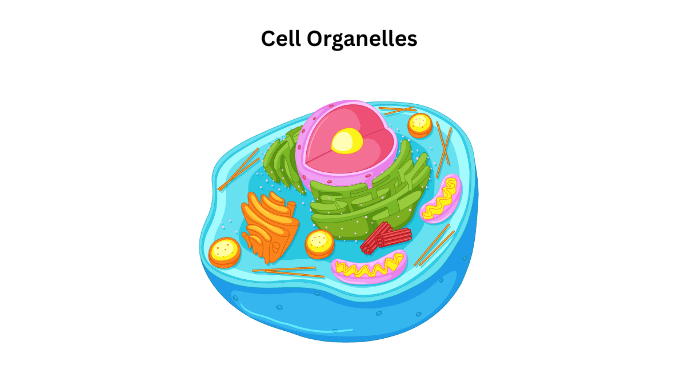
Cell Organelles
Cell organelles are membrane-bound subunits within the cell with specific functions. The cell is the structural and functional unit of life. All cells come from pre-existing cells. Cells are shaped according to the function they perform in the body. The control center of the cell is the nucleus. Based on the type of nucleus, cells can be prokaryotic or eukaryotic. Prokaryotic cells lack membrane-bound nuclei and also organelles are very few organelles. Eukaryotic cells have membrane-bound nuclei with many organelles. Plant cells and animal cells differ in certain aspects, which we will see in this topic.
Cell organelles of the animal cell:
-
Cell membrane

Also known as the plasma membrane, is a thin, flexible, film-like covering surrounding the cytoplasm. It is made up of lipoproteins and is semi-permeable.
Function
Regulates the entry of solutes and ions into and out of the cell. It maintains the shape of the cell, too.
-
Cytoplasm
Jelly-like, the semi-fluid general mass of protoplasm excluding the nucleus. It includes cytoplasmic matrix and cell organelles. It contains various organic and inorganic compounds.
Function
The Matrix is the site of synthesis of several biochemicals like fats, carbohydrates, and proteins. The initial pathway of respiration (glycolysis) takes place in the matrix.
-
Endomembrane system
A group of a few membrane-bound organelles functioning in close coordination with each other. The endoplasmic reticulum, Golgi complex, lysosome, and vacuoles are included in this system.
An irregular network of membrane-lined channels through the cytoplasm. It exists in three forms: cisternae, vesicles, and tubules. It is continuous with the plasma membrane and nuclear membrane. If ribosomes are present on the surface then it is a rough ER, When ribosomes are absent, it is a smooth ER.
Function
It is the supporting framework of the cell. Rough ER provides for protein synthesis. Smooth ER is involved in the synthesis of lipids. and glycogen.
Flattened stacks of membranes. It is made up of four parts: cisternae, tubules, vesicles, and Golgian vacuoles.
Function
It helps in the processing, packaging, transport, and release of secretory proteins, enzymes, and hormones. Forms the acrosome of the sperm.
-
Lysosomes
Single membrane-bound small vesicular organelles containing hydrolytic enzymes.
Function
Carries out intracellular digestion. In injured cells, the lysosomal enzymes lyse or digest the weakened cell. Hence they are also called the suicide bags of the cell.
-
Vacuoles
These are non-cytoplasmic areas present inside the cytoplasm. It’s surrounded by a single membrane called tonoplast. They are formed from the ER.
Vacuoles are big and centrally located in plant cells. In animal cells, they are small and scattered in the cytoplasm.
Functions
It helps in the storage of food, water, pigment, and waste products. In plants, it gives turgidity.
-
Ribosomes
They are naked ribonucleoprotein protoplasmic particles not surrounded by membranes. It is made up of a smaller subunit and a larger subunit. The eukaryotic ribosome is 80S, and the prokaryotic ribosome is 70S.
Function
Ribosomes are sites of protein synthesis.
These are semi-autonomous organelles with their own DNA. Double membrane-bound organelles. Their inner membrane is infolded to form cristae into the matrix.
Function
They are the powerhouse of the cell as they help in cellular respiration (aerobic).
The largest, double membrane-bound cell organelle containing nucleoplasm, nucleolus, and chromatin. The nuclear membrane has pores in between. Chromatin is a hereditary material.
Function
It regulates the cell functions. contain chromosomes that store genetic information and transmit it to the next generation.
-
Centrosomes and Centrioles
Found only in the animal cells near the nucleus. Centrioles occur in pairs at right angles to each other. They are surrounded by centrosomes. Centrioles possess microtubular structures of a 9+0 arrangement.
Function
Initiates and regulates cell division by forming asters and spindles.
-
Peroxisomes
Spherical, sac-like, single membrane-bound microbodies. They are in close association with the ER, mitochondria, and chloroplasts. These contain enzymes for peroxide biosynthesis.
Function
In animal cells, they metabolize toxic substances like nitrite and phenol.
In plant cells, they perform photorespiration.
Cell organelles of the plant cell
Plant cells have all the above organelles as in animal cells, except centrosomes and centrioles. The following organelles and structures are exclusive to plant cells.
-
Plastids
Plastids are pigment-containing cell organelles found in plant cells only. Chloroplast, chromoplast, and leucoplast are three types of plastids based on pigments.
Plastids are double membrane-bound structures with their own DNA. It is also a semi-autonomous organelle.
Function
Chloroplasts are chlorophyll-containing organelles that perform photosynthesis. Chromoplasts contain pigments like xanthophylls and carotene that impart color to flowers and fruits. Leucoplasts store nutrients like starch and proteins.
-
Cell wall
It is a nonliving, rigid layer surrounding the plasma membrane. It occurs in plants, fungi, and protists. The plant cell wall is made up of cellulose, hemicellulose, and pectin. It is comprised of the middle lamella, primary wall, and secondary wall. Connections called plasmodesmata occur as connections between adjacent cell walls.
Function
Provides mechanical support, shape, and rigidity, and protection to the plant cells. Counteracts osmotic pressure and prevents bursting of the cells due to endosmosis.
Reference
Cell Biology and Molecular Biology by N. Arumugam

Leave a Reply